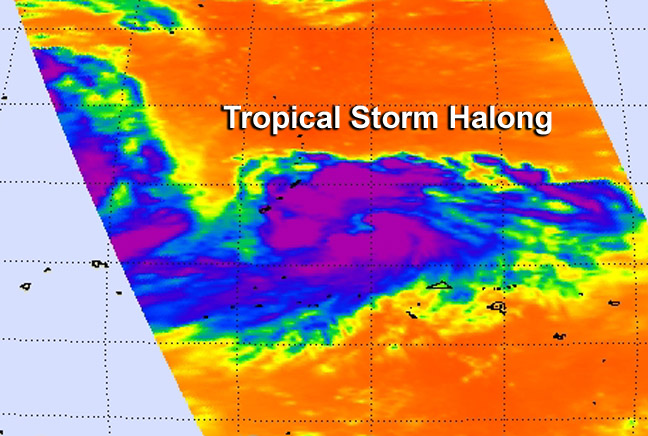NASA Sees Developing Tropical Storm Halong Causing Warnings

NASA's Aqua satellite passed over Tropical Storm Halong on July 29 at 03:29 UTC infrared data showed very cold thunderstorm cloud top temperatures of surrounding the center and developing eye. Image Credit: NASA JPL
When NASA's Aqua satellite passed over Tropical Storm Halong on July 29 at 03:29 UTC (July 28 at 11:29 p.m. EDT) the Atmospheric Infrared Sounder instrument captured data on the cloud cover.
The infrared data showed very cold, high thunderstorm cloud top temperatures of powerful storms surrounding the center, with what appears to be an eye developing.
Microwave satellite data also shows a small eye, with tightly-curved bands of thunderstorms wrapping into it.
A warning is in force for Rota and a Tropical Storm Watch is in effect for Guam, while a typhoon watch is also in effect got Guam.
On July 29 at 1500 UTC (11 a.m. EDT), Tropical Storm Halong's maximum sustained winds were near 55 knots (63.2 mph/101.9 kph). Halong was centered near 13.7 north latitude, approximately 134 nautical miles (154 miles/248 km) east of Andersen Air Force Base.
Halong has tracked northwestward at 11 knots (12.6 mph/20.3 kph).
The Joint Typhoon Warning Center forecast indicates that Halong will move to the west-northwest through the Marianas Islands while continuing to intensify.
Text credit: Rob Gutro
NASA's Goddard Space Flight Center
Media Contact
All latest news from the category: Earth Sciences
Earth Sciences (also referred to as Geosciences), which deals with basic issues surrounding our planet, plays a vital role in the area of energy and raw materials supply.
Earth Sciences comprises subjects such as geology, geography, geological informatics, paleontology, mineralogy, petrography, crystallography, geophysics, geodesy, glaciology, cartography, photogrammetry, meteorology and seismology, early-warning systems, earthquake research and polar research.
Newest articles

“Nanostitches” enable lighter and tougher composite materials
In research that may lead to next-generation airplanes and spacecraft, MIT engineers used carbon nanotubes to prevent cracking in multilayered composites. To save on fuel and reduce aircraft emissions, engineers…

Trash to treasure
Researchers turn metal waste into catalyst for hydrogen. Scientists have found a way to transform metal waste into a highly efficient catalyst to make hydrogen from water, a discovery that…

Real-time detection of infectious disease viruses
… by searching for molecular fingerprinting. A research team consisting of Professor Kyoung-Duck Park and Taeyoung Moon and Huitae Joo, PhD candidates, from the Department of Physics at Pohang University…




















